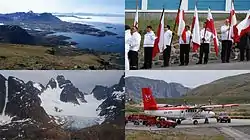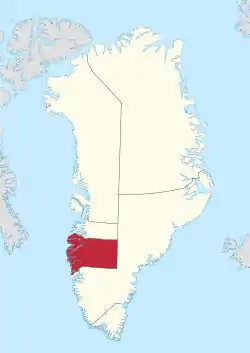Qeqqata
Qeqqata (Greenlandic pronunciation: [qeqːata], The Center, Danish: Centrum) is a municipality in western Greenland, operational from 1 January 2009. The municipality was named after its location in the central-western part of the country.[4] Its population is 9,378 as of January 2020.[3] The administrative center of the municipality is in Sisimiut (formerly called Holsteinsborg). It consists of the previously unincorporated area of Kangerlussuaq, as well as two former municipalities of western Greenland:
Qeqqata Municipality
Qeqqata Kommunia | |
|---|---|
 | |
 Coat of arms | |
 Location of the Qeqqata municipality within Greenland | |
| Coordinates (Qeqqata Commune): 66°30′N 48°00′W | |
| Sovereign state | |
| Autonomous country | |
| Municipality | |
| Established | 1 January 2009 |
| Municipal center | Sisimiut |
| Government | |
| • Mayor | Malik Berthelsen (Siumut) |
| Area | |
| • Total | 115,500 km2 (44,595 sq mi) |
| Population (2020)[3] | |
| • Total | 9,378 |
| • Density | 0.081/km2 (0.21/sq mi) |
| Time zone | UTC-03 |
| Calling code | +299 |
| ISO 3166 code | GL-QE |
| Website | qeqqata.gl |
Geography
In the south and east, the municipality is flanked by the Sermersooq municipality, although settlements and associated trade is concentrated mainly alongside the coast. In the north, it is bordered by the Qeqertalik municipality. The waters of the western coast are that of the Davis Strait, separating Greenland from Baffin Island. With an area of 115,500 km2 (44,594.8 sq mi) it is the second-smallest municipality of Greenland after Kujalleq.
Politics
Avannaata's municipal council consists of 15 members, elected every four years. [5]
Municipal council
| Election | Party | Total seats |
Turnout | Elected mayor | ||
|---|---|---|---|---|---|---|
| A | IA | S | ||||
| 2017 | 3 | 3 | 9 | 15 | 61.1% | Malik Berthelsen (S) |
Towns and settlements
- Maniitsoq area
- Maniitsoq (Sukkertoppen)
- Atammik
- Kangaamiut
- Napasoq
- Sisimiut area
- Sisimiut (Holsteinsborg)
- Itilleq
- Kangerlussuaq (Søndrestrøm)
- Sarfannguit
Transport
Like all of Greenland, there are no roads between settlements. There are three airports in Qeqqata, Kangerlussuaq, Maniitsoq and Sisimiut, where Kangerlussuaq is the international hub for Greenland. Other settlements are served by boats.
A simple road for terrain vehicles between Kangerlussuaq and Sisimiut was approved in June 2020. Construction of the first 21 km of the road, connecting Kangerlussuaq with the Tasersuaq area, is scheduled to begin in late July 2020. [6][7]
See also
References
| Wikimedia Commons has media related to Qeqqata. |
- Qeqqata Municipality Archived March 6, 2012, at the Wayback Machine (in Greenlandic)
- Statistics Greenland, Greenland in Figures 2010
- "Population by Localities". Statistical Greenland. Retrieved 7 April 2020.
- Qeqqata Kommunia, municipal page
- Qeqqata.gl "Kommunalbestyrelsen"
- Greenland’s first road project connecting settlements clears its last hurdle
- First overland road project between Greenlandic towns
